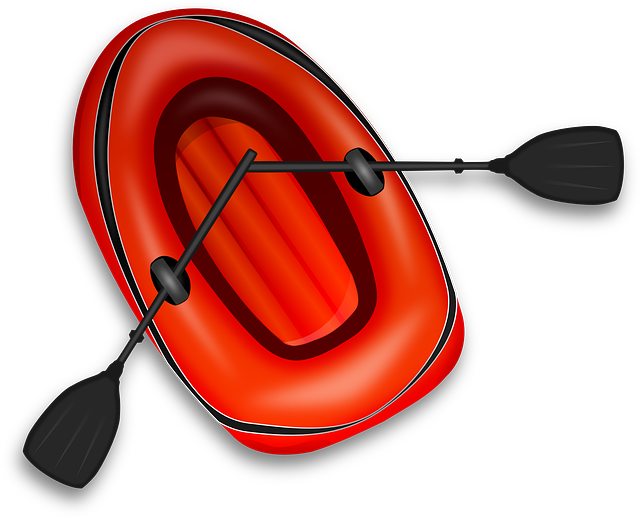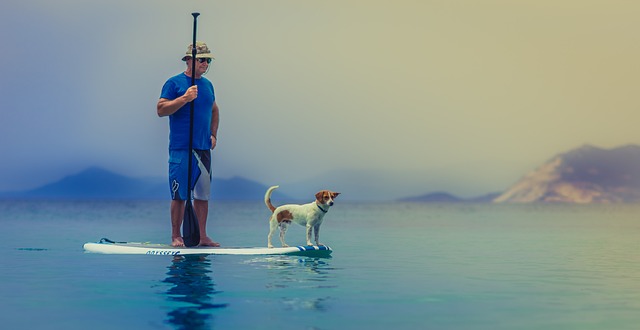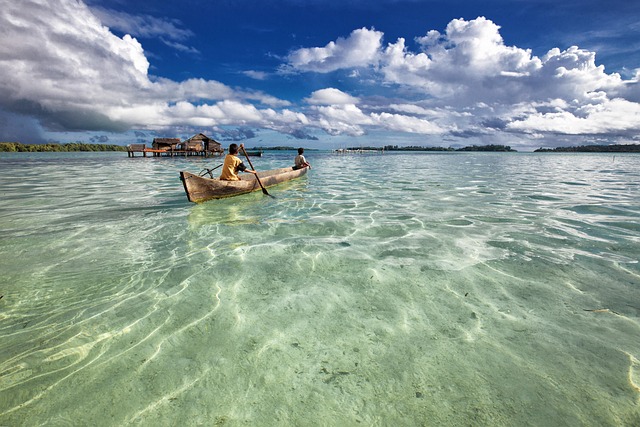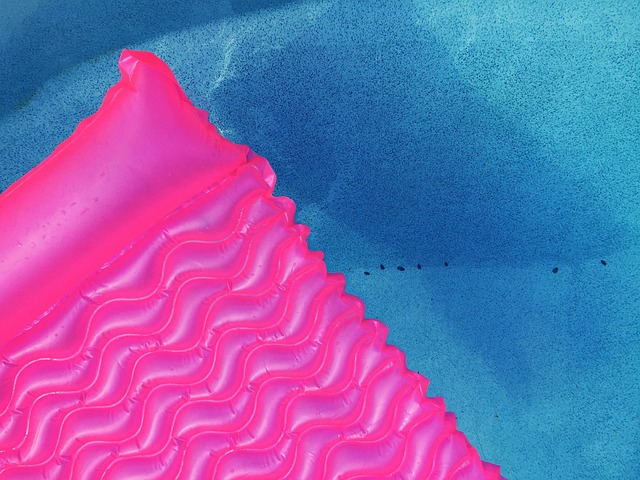Inflatable paddle boards (IPBs) with non-slip deck surfaces have revolutionized water sports by enhancing safety and performance. Advanced technologies, like specialized grip patterns and anti-slip coatings, provide superior traction in wet conditions. Textured surfaces improve stability, especially in choppy waters, catering to both casual and avid paddlers. Composite decking is a durable slip-resistant option for outdoor spaces. Non-slip coatings reduce accident risks and improve board control. IPBs offer excellent stability despite misconceptions about their balance. Eco-friendly materials like recycled plastic minimize environmental impact. Future trends include natural patterns, smart materials, and pressure-sensitive technologies for adaptive non-slip surfaces, ensuring safe and enjoyable experiences for all best inflatable paddle board users.
In today’s active water sports scene, ensuring safe and durable deck surfaces is paramount. This article explores the transformative power of non-slip technologies, delving into their crucial role in enhancing safety for enthusiasts across diverse water activities. From understanding advanced non-slip coatings to navigating the challenges of inflatable stability, we uncover best practices for choosing materials that promise longevity. Discover top advantages, real-world applications, and sustainable alternatives shaping the future of best inflatable paddle boards, revolutionizing experiences while prioritizing environmental impact.
Understanding Non-Slip Technologies for Water Sports Safety

In the world of water sports, ensuring safety is paramount, especially for activities like stand-up paddle boarding (SUP) on inflatable boards, which have gained immense popularity due to their portability and accessibility. Non-slip deck surfaces play a pivotal role in preventing accidents and enhancing rider control. The technology behind these surfaces has evolved significantly, focusing on creating textures that disrupt the shoe-deck interaction, thereby reducing the risk of slipping.
One of the most advanced non-slip technologies is often found on top-tier inflatable paddle boards. These boards incorporate specialized grip patterns or materials that provide exceptional traction, even in wet conditions. For instance, some manufacturers use a combination of raised ridges and anti-slip coatings to create a robust grip, allowing paddlers to maintain stability during high-intensity exercises or when navigating challenging waters. Understanding these technologies is crucial for water sports enthusiasts looking to invest in the best inflatable paddle board that offers both performance and safety.
The Role of Textured Surfaces in Inflatable Paddle Board Design

Inflatable paddle boards have evolved significantly, and one key area of improvement is the adoption of textured surfaces. These aren’t just for grip; they play a crucial role in enhancing performance and safety, especially when navigating choppy waters or participating in competitive paddling. A best inflatable paddle board with a textured deck offers several advantages. Firstly, it improves traction, ensuring users don’t slip off, which is vital for prolonged comfort and control during paddling sessions. This is particularly beneficial for folks who prefer longer, more intense workouts on their boards.
Moreover, textured surfaces contribute to better stability. They help the board maintain its shape and reduce the risk of shifting or flipping, making them ideal for various water conditions. For enthusiasts seeking a dynamic and responsive paddle experience, these deck textures are a game-changer, elevating the overall quality of their best inflatable paddle board.
Best Practices for Choosing a Safe and Durable Deck Material

When selecting a non-slip deck surface for your outdoor space, prioritizing safety and durability is paramount, especially if you’re considering a best inflatable paddle board setup. The ideal material offers not just a secure standing platform but also withstands the rigors of frequent use and varying weather conditions. One proven option is composite decking, known for its slip-resistant properties and longevity. This synthetic material blend provides excellent traction, even when wet, making it a top choice for water-based activities like paddle boarding.
For a best inflatable paddle board setup, opt for wider deck boards that offer ample footroom and stability. Textured surfaces within the decking itself can further enhance grip, ensuring users remain firmly planted during paddling or balancing acts. Regular cleaning and maintenance are also essential to preserve the non-slip coating and overall material integrity, thus ensuring your deck remains a safe haven for both casual and avid paddle boarders alike.
Top Advantages of Non-Slip Coatings on Paddling Equipment

Non-slip coatings on paddling equipment, especially for best inflatable paddle boards, offer significant advantages that enhance safety and performance. One of the primary benefits is improved traction, ensuring a secure grip while standing or performing various water manoeuvres. This feature is particularly crucial for stability and balance, especially during high-intensity activities like surfing waves or racing.
Moreover, non-slip surfaces reduce the risk of accidents and injuries by minimising the chances of slipping or losing control. For enthusiasts and professionals alike, this added security allows them to focus more on enjoying the water sports experience without worrying about unexpected slips. Additionally, these coatings contribute to better board control, enabling users to navigate through different water conditions with greater ease and precision, making the best inflatable paddle boards even more efficient and enjoyable to use.
Common Challenges and Misconceptions About Inflatable Stability

Inflatable stability, while often overlooked, presents several challenges that users might not immediately consider. One of the primary concerns is the misconception that an inflatable paddle board (IPB) will always be less stable than its rigid counterparts. This isn’t entirely true; with the right design and quality materials, IPBs can offer excellent stability for riders of all skill levels. However, factors like water displacement, air pressure, and center of gravity play significant roles in determining balance.
Another challenge is the common belief that inflating an IPB to maximum capacity ensures optimal stability. In reality, over-inflating can lead to poor control and increased chances of tipping over. The best inflatable paddle board should strike a balance between rigidity for stability and flexibility for maneuverability. Understanding these nuances and learning proper paddling techniques are essential to navigating the water safely and enjoying the benefits of an IPB, whether for recreation or competitive sports.
Real-World Applications: Enhancing Safety for All Water Enthusiasts

Non-slip deck surfaces have revolutionized water activities, offering enhanced safety for users of all skill levels and interests. From the calm waters of lakes to the choppy seas, having a secure standing area is paramount for water enthusiasts. This technology is particularly beneficial for popular activities like stand-up paddle boarding (SUP), where balance is key. The best inflatable paddle board on the market today often features non-slip coatings, ensuring paddlers can maintain their grip while enjoying the tranquil beauty of nature.
By reducing the risk of accidents and falls, these surfaces contribute to a more inclusive water sports experience. Whether it’s casual paddlers exploring local rivers or professional athletes training for competitions, everyone can benefit from the added stability. Moreover, non-slip decks extend beyond safety; they enhance performance by allowing athletes to focus on their technique without worrying about slipping.
Environmental Impact and Sustainable Alternatives in Deck Surfaces

In recent years, there’s been a growing awareness of the environmental impact associated with traditional deck surfaces, such as wood and composite materials. These materials often require extensive processing, leading to significant carbon footprints. Additionally, wooden decks may contribute to water pollution if not properly maintained or disposed of. To mitigate these issues, many eco-conscious consumers are turning towards sustainable alternatives for their deck surfaces.
One promising option gaining traction is the use of recycled materials and natural composites, which offer both durability and environmental friendliness. For instance, best inflatable paddle board manufacturers are exploring ways to incorporate recycled plastic into their products, reducing the demand for new resources. These innovative designs not only provide slip-resistant properties but also contribute to a circular economy by minimizing waste and preserving natural resources, making them attractive choices for those seeking eco-friendly deck solutions.
Future Trends: Innovations Shaping the Non-Slip Paddle Board Experience

The future of non-slip deck surfaces in paddle boarding looks set to be shaped by innovative technologies and materials, further enhancing the overall experience for users of the best inflatable paddle board. One emerging trend is the integration of advanced grip patterns inspired by nature, such as microscopic textures mimicking the surface of sea plants or sand grains. These designs offer superior traction without compromising on the board’s glide, allowing paddlers to maintain control during long-distance voyages or intense workouts.
Additionally, smart materials and sensors are being explored to create dynamic non-slip coatings that adapt to environmental conditions. For instance, self-cleaning surfaces could become commonplace, repelling water, mud, and other debris, ensuring consistent traction. Moreover, the integration of pressure-sensitive technology might enable personalized grip adjustments based on individual paddling styles, catering to a wide range of users seeking optimal performance and safety on their next adventure on the best inflatable paddle board.
